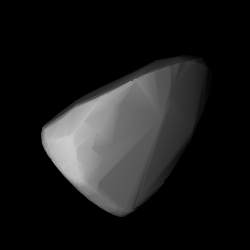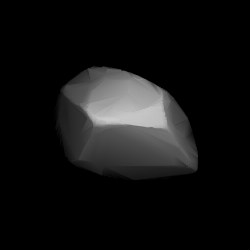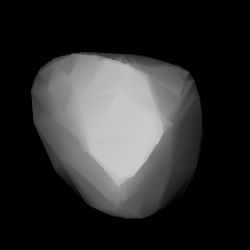Related Research Articles

2829 Bobhope is a dark asteroid of the Meliboea family, from the outer region of the asteroid belt. It was discovered on 9 August 1948, by South African astronomer Ernest Leonard Johnson at Union Observatory in Johannesburg. The asteroid was later named after comedian Bob Hope. The asteroid has a rotation period of 6.1 hours and measures approximately 37 kilometers in diameter.
1024 Hale, provisional designation A923 YO13, is a carbonaceous background asteroid from the outer regions of the asteroid belt, approximately 45 kilometers (28 miles) in diameter. The asteroid was discovered on 2 December 1923, by Belgian–American astronomer George Van Biesbroeck at the Yerkes Observatory in Wisconsin, United States. It was named for American astronomer George Ellery Hale. The dark C-type asteroid may have a rotation period of 16 hours.
1178 Irmela, provisional designation 1931 EC, is a stony asteroid from the middle regions of the asteroid belt, approximately 19 kilometers in diameter.
1049 Gotho, provisional designation 1925 RB, is a carbonaceous asteroid from the outer region of the asteroid belt, approximately 53 kilometers in diameter. It was discovered on 14 September 1925, by German astronomer Karl Reinmuth at Heidelberg Observatory in southwest Germany. Although the name of the asteroid is a masculine German name, it is not known to refer to a particular individual.
1096 Reunerta, provisional designation 1928 OB, is an asteroid from the background population of the asteroid belt's central region, approximately 40 kilometers in diameter. It was discovered on 21 July 1928, by astronomer Harry Edwin Wood at the Union Observatory in Johannesburg, South Africa. The asteroid was named after South African engineer Theodore Reunert, supporter of the observatory and friend of the discoverer.

1554 Yugoslavia, provisional designation 1940 RE, is a stony Eunomian asteroid from the middle region of the asteroid belt, approximately 16 kilometres (9.9 mi) in diameter. It was discovered by Serbian astronomer Milorad Protić at Belgrade Astronomical Observatory, Serbia, on 6 September 1940. It was named for the former country of Yugoslavia.

1127 Mimi is a dark background asteroid from the central regions of the asteroid belt. It was discovered on 13 January 1929, by Belgian astronomer Sylvain Arend at the Royal Observatory of Belgium in Uccle. The carbonaceous C-type asteroids (CX) has a rotation period of 12.7 hours and measures approximately 47 kilometers in diameter. Through a glitch in the naming process, the asteroid received the name "Mimi" instead of "Robelmonte" as originally intended by the discoverer.

1165 Imprinetta, provisional designation 1930 HM, is a carbonaceous Meliboean asteroid from the outer regions of the asteroid belt, approximately 49 kilometers (30 mi) in diameter. It was discovered on 24 April 1930 by Dutch astronomer Hendrik van Gent at the Union Observatory in Johannesburg, South Africa. The asteroid was named after Imprinetta Gent, wife of the discoverer.
1194 Aletta, provisional designation 1931 JG, is a carbonaceous asteroid from the outer region of the asteroid belt, approximately 55 kilometers in diameter. It was discovered on 13 May 1931, by South African astronomer Cyril Jackson at Johannesburg Observatory in South Africa. It was later named after the discoverer's wife Aletta Jackson.
11277 Ballard (provisional designation 1988 TW2) is a Phocaea asteroid from the inner regions of the asteroid belt, approximately 6.3 kilometers (3.9 miles) in diameter. It was discovered on 8 October 1988, by American astronomer couple Carolyn and Eugene Shoemaker at the Palomar Observatory in California. The assumed S-type asteroid has a rotation period of at least 10 hours. It was named for American marine scientist Robert Ballard.
1815 Beethoven, provisional designation 1932 CE1, is a carbonaceous background asteroid from the outer regions of the asteroid belt, approximately 30 kilometers (19 miles) in diameter. It was discovered on 27 January 1932, by German astronomer Karl Reinmuth at the Heidelberg Observatory. The uncommon F-type asteroid seems to have a long rotation period of 54 hours (tentative). It was named after Ludwig van Beethoven.
2038 Bistro, provisional designation 1973 WF, is a stony asteroid from the inner regions of the asteroid belt, approximately 12 kilometers in diameter. The asteroid was discovered on 24 November 1973, by Swiss astronomer Paul Wild at the Zimmerwald Observatory near Bern, Switzerland. It was named for the Bistro restaurant.
2008 Konstitutsiya, provisionally designated 1973 SV4, is a carbonaceous asteroid from the outer region of the asteroid belt, approximately 50 kilometers in diameter. It was discovered on 27 September 1973, by Soviet astronomer Lyudmila Chernykh at the Crimean Astrophysical Observatory in Nauchnyj, on the Crimean peninsula. The asteroid was named for the 1977 Soviet Constitution.
1284 Latvia, provisional designation 1933 OP, is a rare-type asteroid from the middle region of the asteroid belt, approximately 37 kilometers in diameter. It was discovered on 27 July 1933, by German astronomer Karl Reinmuth at Heidelberg Observatory in southern Germany, and named after the Republic of Latvia.
1383 Limburgia, provisional designation 1934 RV, is a carbonaceous asteroid from the outer region of the asteroid belt, approximately 23 kilometers in diameter. It was discovered on 9 September 1934, by Dutch astronomer Hendrik van Gent at the Leiden Southern Station, annex to the Johannesburg Observatory in South Africa. It is named for the Dutch province Limburg.
1359 Prieska, provisional designation 1935 OC, is a rare-type carbonaceous asteroid from the outer region of the asteroid belt, approximately 50 kilometers in diameter. It was discovered on 22 July 1935, by English-born South-African astronomer Cyril Jackson at Johannesburg Observatory in South Africa. The asteroid was named after the South African town of Prieska.
1258 Sicilia, provisional designation 1932 PG, is a dark background asteroid from the outer regions of the asteroid belt, approximately 44 kilometers in diameter. It was discovered on 8 August 1932, by astronomer Karl Reinmuth at the Heidelberg-Königstuhl State Observatory in southwest Germany. The asteroid was named after the Italian island of Sicily.
1330 Spiridonia, provisional designation 1925 DB, is a dark background asteroid of primitive composition, located in the outer regions of the asteroid belt, approximately 65 kilometers in diameter. It was discovered on 17 February 1925, by Soviet astronomer Vladimir Albitsky at the Simeiz Observatory on the Crimean peninsula. The asteroid was named after the discoverer's brother-in-law, Spiridon Zaslavskij.
1266 Tone is a dark background asteroid from the outer regions of the asteroid belt, approximately 80 kilometers in diameter. Discovered by astronomer Okuro Oikawa at the Tokyo Observatory in 1927, it was assigned the provisional designation 1927 BD. The asteroid was later named after the Tone River, one of Japan's largest rivers.
3682 Welther, provisional designation A923 NB, is a background asteroid from the central regions of the asteroid belt, approximately 19 kilometers in diameter. It was discovered on 12 July 1923, by German astronomer Karl Reinmuth at the Heidelberg Observatory in southwest Germany. The asteroid has a rotation period of 3.6 hours. It was named after Barbara Welther, an American historian of science at CfA.
References
- 1 2 3 4 "JPL Small-Body Database Browser: 1027 Aesculapia (A923 YO11)" (2016-06-09 last obs.). Jet Propulsion Laboratory . Retrieved 8 February 2017.
- ↑ "Æsculapius" . Oxford English Dictionary (Online ed.). Oxford University Press.(Subscription or participating institution membership required.)
- 1 2 3 4 Schmadel, Lutz D. (2007). "(1027) Aesculapia". Dictionary of Minor Planet Names – (1027) Aesculapia. Springer Berlin Heidelberg. p. 88. doi:10.1007/978-3-540-29925-7_1028. ISBN 978-3-540-00238-3.
- 1 2 3 4 5 6 7 "LCDB Data for (1027) Aesculapia". Asteroid Lightcurve Database (LCDB). Retrieved 8 February 2017.
- 1 2 3 Masiero, Joseph R.; Grav, T.; Mainzer, A. K.; Nugent, C. R.; Bauer, J. M.; Stevenson, R.; et al. (August 2014). "Main-belt Asteroids with WISE/NEOWISE: Near-infrared Albedos". The Astrophysical Journal. 791 (2): 11. arXiv: 1406.6645 . Bibcode:2014ApJ...791..121M. doi:10.1088/0004-637X/791/2/121. S2CID 119293330 . Retrieved 8 February 2017.
- 1 2 3 4 Tedesco, E. F.; Noah, P. V.; Noah, M.; Price, S. D. (October 2004). "IRAS Minor Planet Survey V6.0". NASA Planetary Data System. 12: IRAS-A-FPA-3-RDR-IMPS-V6.0. Bibcode:2004PDSS...12.....T . Retrieved 22 October 2019.
- 1 2 3 4 Nugent, C. R.; Mainzer, A.; Bauer, J.; Cutri, R. M.; Kramer, E. A.; Grav, T.; et al. (September 2016). "NEOWISE Reactivation Mission Year Two: Asteroid Diameters and Albedos". The Astronomical Journal. 152 (3): 12. arXiv: 1606.08923 . Bibcode:2016AJ....152...63N. doi: 10.3847/0004-6256/152/3/63 .
- 1 2 3 4 Mainzer, A.; Grav, T.; Masiero, J.; Hand, E.; Bauer, J.; Tholen, D.; et al. (November 2011). "NEOWISE Studies of Spectrophotometrically Classified Asteroids: Preliminary Results". The Astrophysical Journal. 741 (2): 25. arXiv: 1109.6407 . Bibcode:2011ApJ...741...90M. doi:10.1088/0004-637X/741/2/90. S2CID 35447010.
- 1 2 3 4 Nugent, C. R.; Mainzer, A.; Masiero, J.; Bauer, J.; Cutri, R. M.; Grav, T.; et al. (December 2015). "NEOWISE Reactivation Mission Year One: Preliminary Asteroid Diameters and Albedos". The Astrophysical Journal. 814 (2): 13. arXiv: 1509.02522 . Bibcode:2015ApJ...814..117N. doi:10.1088/0004-637X/814/2/117. S2CID 9341381 . Retrieved 8 February 2017.
- 1 2 3 4 Usui, Fumihiko; Kuroda, Daisuke; Müller, Thomas G.; Hasegawa, Sunao; Ishiguro, Masateru; Ootsubo, Takafumi; et al. (October 2011). "Asteroid Catalog Using Akari: AKARI/IRC Mid-Infrared Asteroid Survey". Publications of the Astronomical Society of Japan. 63 (5): 1117–1138. Bibcode:2011PASJ...63.1117U. doi:10.1093/pasj/63.5.1117. (online, AcuA catalog p. 153)
- 1 2 Maleszewski, Chester; Clark, Maurice (December 2004). "Bucknell University Observatory lightcurve results for 2003-2004". The Minor Planet Bulletin. 31 (4): 93–94. Bibcode:2004MPBu...31...93M. ISSN 1052-8091 . Retrieved 8 February 2017.
- 1 2 Ehlert, Steven; Kingery, Aaron (July 2015). "New Lightcurves of 1027 Aesculapia and 3395 Jitka". The Minor Planet Bulletin. 42 (3): 211. Bibcode:2015MPBu...42..211E. ISSN 1052-8091 . Retrieved 8 February 2017.
- 1 2 Behrend, Raoul. "Asteroids and comets rotation curves – (1027) Aesculapia". Geneva Observatory . Retrieved 8 February 2017.
- 1 2 3 Waszczak, Adam; Chang, Chan-Kao; Ofek, Eran O.; Laher, Russ; Masci, Frank; Levitan, David; et al. (September 2015). "Asteroid Light Curves from the Palomar Transient Factory Survey: Rotation Periods and Phase Functions from Sparse Photometry". The Astronomical Journal. 150 (3): 35. arXiv: 1504.04041 . Bibcode:2015AJ....150...75W. doi:10.1088/0004-6256/150/3/75. S2CID 8342929 . Retrieved 8 February 2017.
- 1 2 "1027 Aesculapia (A923 YO11)". Minor Planet Center. Retrieved 8 February 2017.
- Hess, Kylie; Bruner, Madison; Ditteon, Richard (January 2017). "The Minor Planet Bulletin: Asteroid Lightcurve Analysis at the Oakley Southern Sky Observatory: 2015 February–March". Bulletin of the Minor Planets Section of the Association of Lunar and Planetary Observers. 44 (1): 3–4. Bibcode:2017MPBu...44....3H. ISSN 1052-8091.